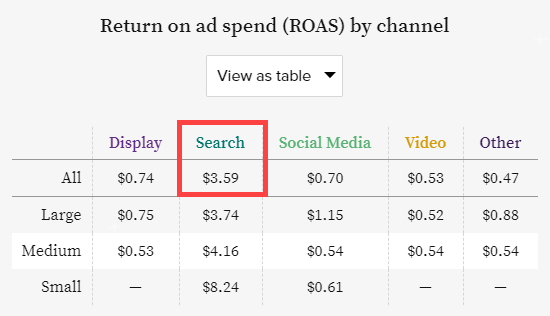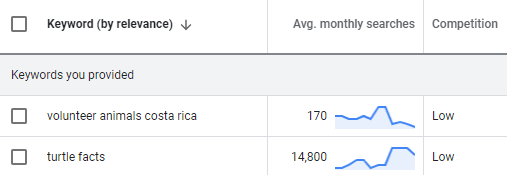There are no universal recipes; each organization must design a custom strategy for their needs. It mainly depends on 3 factors:
- Organization’s goals (and whether advertising on Google can help achieve them or not)
- Search volume (if many people search on Google what the organization offers or at least related topics)
- Organization’s resources (if you have people who know about Google Ads or can learn, if you have time available to dedicate to it or budget to hire an external consultant, if you have a website with many articles and programs to promote or not…)
Below we explain these 3 elements:
1.1. Think about how to match the goals of your organization with Google searches
Google Ad Grants gives your non-profit a budget of $10,000/month to place your ads in Google’s search results.

Therefore, the first thing is to consider what Google searches could help you connect with your target audience and achieve the organization’s goals.
Depending on the case, the connection can be direct or indirect. For example, suppose you are an organization that protects turtles in Costa Rica and are looking for volunteers:
- Direct connection: The user searches for ”volunteer animals costa rica” in Google and your organization shows an ad directly promoting your volunteer program with animals in Costa Rica.
- Indirect connection: The user searches for ”fun facts turtles” on Google and your organization shows an ad promoting an article with information about turtles. At the end of the article, you invite users to sign up as volunteers.
Another example of what a direct flow would look like, in this case to get donations:

And how could an indirect flow be for that same goal:

Direct connection is easier, but direct searches tend to be low in volume and/or very competitive (many nonprofits want to attract collaborators, while there are relatively few users searching Google for nonprofits).
The indirect connection requires more ”effort” (converting people who do generic searches into collaborators of your nonprofit’s not so easy, it requires a good strategy), but they are usually searches with much more volume and less competition.
Therefore, you must first consider your nonprofit’s main goals (getting donations, recruiting volunteers, informing society about an issue, promoting events, attracting firms, selling products or services to raise funds…).
And then you have to think about which Google searches could help you achieve those goals, either directly or indirectly.
The mistake of many nonprofits is that they only think about direct connection and are frustrated when they don’t get results.
Google Ad Grants is interesting and profitable for most nonprofits (it’s quite rare that using properly $10,000 a month for free promotion you get zero results). But sometimes it takes some creativity and extra effort to take advantage of indirect connection opportunities as well.
| Direct goals | Indirect goals |
|---|---|
| Raise donations | Capture emails |
| Attract sponsors | Gain followers |
| Recruit volunteers | Get signatures |
| Connect with beneficiaries | Spread content |
| Sell products/services | Offer online resources |
| Sell tickets | Promote events |
Google Ad Grants can also be a good opportunity to test new initiatives and check if there is enough public interest. For example:
- Launch an event that you have not organized before. For example, a concert or race for fundraising (those are things that many users search for on Google). This is especially interesting for nonprofits focused on topics that don’t attract many direct searches (for example, a nonprofit focused on a rare problem or disease).
- Promote your organization (or certain specific initiatives) in a country where you currently have little presence. Showing Google Ads in that country is a low-risk formula for testing interest, before making decisions that are more costly or risky (for example, opening an office in that country or hiring local staff).
- Test if you capture many collaborators by promoting one specific content (an article, a video, a photo gallery…). If it works, it will be interesting to give more visibility to that content and maybe create more similar content.
1.2. Quantify the potential of Google Ad Grants for your nonprofit
Google Ad Grants is a great opportunity for many nonprofits (with $120,000 a year to promote you can do wonders).
According to the 2020 M + R study, nonprofits obtain a ROAS of 3.59 on average in their campaigns on Google and other search engines. That is, for every $1 invested, they get $3.59 of income. Far above social media, video and display campaigns, which normally don’t even achieve a positive ROI (see table):

Therefore, it’s clear that advertising on Google can be very profitable for nonprofits and even more if they give you $120,000 each year in free ads.
But obviously, not all cases are the same. Google Ad Grants does not have the same potential for all nonprofits.
Therefore, it can be interesting to do some quick calculations to assess how big the opportunity is for your organization.
Luckily, Google Ads offers a free tool that allows you to see the monthly volume of users searching for a word/phrase. It also tells us the level of competition that exists for each word and recommends related keywords that may interest us.
You can access the Keyword Planner from your Google Ads account (top menu, ”PLANNING” section). These are the 2 options offered by the Planner:

You need to have a Google Ads account to access the Planner, but you can easily open an account (it’s free and it only takes a couple of minutes), even if it’s just to use this tool for now.
Following the example of the nonprofit dedicated to protecting turtles, we can see how ”volunteer animals costa rica” has only 170 monthly searches, while ”turtle fun facts” has about 14,800 monthly searches.

This example shows that the indirect connection has almost 100 times more searches than the direct connection. And there are cases in which the difference is even greater.
It’s important to choose the correct language and area in this tool. In this example we have haven’t filtered, but if your organization is targeting a specific country or area, you should filter to see the search data for your area of interest.

If you see that the keywords relevant to your organization have a high search volume and low competition, you can probably achieve great things with Google Ad Grants.
On the other hand, if all the relevant keywords have low search volume, it may be interesting to launch some Google Ads Grants campaigns (you will probably achieve some results and it’s free), but it probably won’t have a big impact on your organization.
Based on these figures, you can decide the appropriate strategy:
- If the opportunity is big, you should make it a priority for your organization. You should learn how Google Ad Grants works in-depth or hire an external consultant.
- If the opportunity is small, you should not allocate a lot of resources. Maybe launch only automated campaigns using Smart Campaigns or Dynamic Search Ads (they don’t work as well as manually optimized campaigns, but they are a good option if you want to spend very little time optimizing them).
| Opportunity | Resources to dedicate | Strategy |
|---|---|---|
| Big | Many | Learn Google Ads in-depth or hire a consultant |
| Little | Few | Simple campaigns, perhaps only automated campaigns |
Remember that you should try not only the obvious keywords (“volunteering”,”donations”…), but also less obvious keywords that allow you to reach your target audience (indirect connection).
1.3. Evaluate the skills and time you have
You don’t have to know 100% the options offered by Google Ads to start taking advantage of Google Ad Grants. But keep in mind that the more things you don’t know, the less likely you are to succeed with your campaigns.
Also, optimizing a Google Ad Grants account requires recurring work (minimum 5 hours a month) and more configuration work initially.
The main recurring tasks are:
- Review various reports in Google Ads and Google Analytics
- Pause, change and add keywords
- Pause, change and add ads
- Create and optimize web pages (landing pages)
- Set up and review conversion tracking
- Set up and review automations
- Check that all Google Ad Grants requirements are met
- Review what’s new in Google Ads and evaluate which new features should be tried
If you don’t have much time and/or knowledge, we recommend you hiring an external consultant (we are experts in Google Ad Grants and offer services from $150/month)
If you don’t have time nor the budget to hire a consultant, you can use Smart Campaigns or Dynamic Search Ads. You will not get as good results as with well-optimized ”normal” campaigns, but they are automated solutions that require much less work. These are ”emergency” options, worse than optimizing an account manually but better than not taking advantage of Google Ad Grants at all.
Smart Campaigns are very automated (you enter a few data and the rest is done automatically by Google’s artificial intelligence).
Campaigns with Dynamic Search Ads require a little more work, but the are also a little more customizable. They are something intermediate between manual configuration and Smart Campaigns.
We don’t explain these tow option in detail because the official documentation is relatively good and because it’s not what we recommend in general (automation has its limits and it’s very rare that the system does not make mistakes or miss important opportunities).
| Situation | Recommendation |
|---|---|
| We have time and knowledge | Manually optimize your own account |
| We don’t have time or knowledge, but we do have a budget | Hire a consultant |
| We don’t have time, knowledge or budget | Smart Campaigns or Dynamic Search Ads |